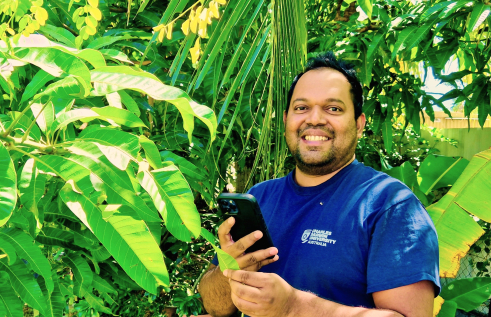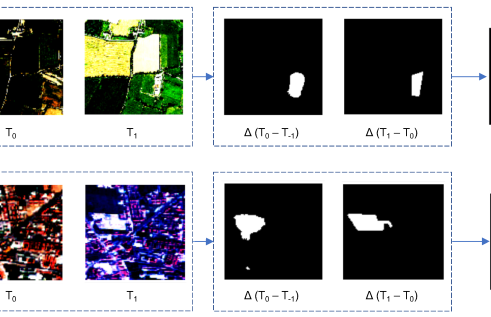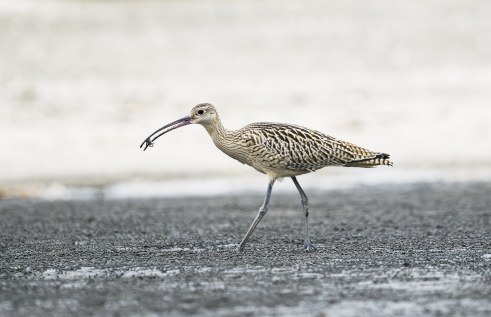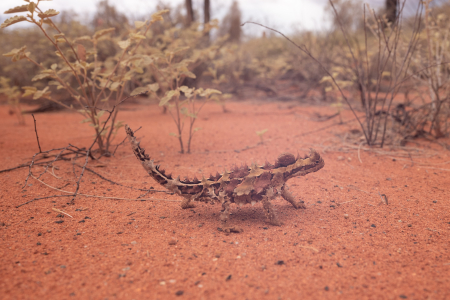News
School students inspire study into Central Australia’s infamous Thorny Devils
A Central Australian researcher from Charles Darwin University (CDU) is analysing the social behaviour and physiology of Australia’s Thorny Devil to answer unexplained questions about the iconic creature.
CDU researcher from Research Institute of Environment and Livelihoods, Dr Christine Schlesinger will seek to find out just how far and wide Thorny Devils, known as ngiyari to local Pitjantjatjara speakers, roam and why so many are spotted on roads.
As a part of her research, Dr Schlesinger will work with students from Nyangatjatjara College in Yulara near Uluṟu, park rangers and community members.
The project has just received $81,000 for over three years from the Herman Slade Foundation to help fund the project that will use observations, radio tracking and remote cameras in an investigation into the Thorny Devil’s habits and interactions in the harsh Central Australian environment.
"The research was conceived following questioning by two young Anangu women, students of Nyangatjatjara College, about why there were so many ngiyari on the roads around Uluṟu between their home and school,” Dr Schlesinger said.
“They are often seen on roads because that’s where people and the lizards cross paths. And they are much easier to see when they’re not camouflaged against the red sand. But we are not sure if they are on the roads by coincidence or for thermo-regulatory purposes.”
Uluṟu-Kata Tjuṯa National Park Manager Dianne Scopel said the engagement of Indigenous students from local Nyangatjatjara College provided the perfect opportunity to extend the classroom into the park.
“Ngiyara is a culturally significant species for Anangu and the research project allowed local students and elders the opportunity to engage with scientists and help inform the management and conservation of the species within the National Park,” Ms Scopel.
Nyangatjatjara College Principal Mike Tucker said the study was a great learning opportunity for the students.
“We are really pleased to develop this partnership with CDU and Uluṟu-Kata Tjuta National Park to give our students authentic experiences with western science and its processes while at the same time, connecting with the work of a range of other stakeholders,” Mr Tucker said.
Dr Schlesinger said ngiyari lived mostly in remote sandy deserts dominated by spinifex and don’t move far from their burrows except for a few months in Autumn and Spring each year. For these reasons, despite being widespread, ngiyari are rarely seen.
“These are remote areas, so surveying and studying movements, requires a little bit of creativity,” Dr Schlesinger said.
Dr Schlesinger said Nyangatjatjara College students would be a vital part of the research as they record and report on any ngiyari sightings, especially as they travel to and from school each day.
“As well as the students, we plan to enlist as many citizen scientists from the local community as possible to assist with the project and look out for thorny devils, and so far there has been lots of enthusiasm,” she said.
“The methods used, and data collected will be discussed and evaluated as part of the school curriculum.”
Related Articles

Rooting out plant diseases: Are computers ready to run our farms?
Nature is still too complex for artificial intelligence (AI) modelling to be effective, but the tipping point is close, according to a new study that found the technology may still trip at the last real-world hurdle.
Read more about Rooting out plant diseases: Are computers ready to run our farms?
Tech on the treetops: How AI can protect forests
The Artificial Intelligence model was developed to detect changes in forest cover.
Read more about Tech on the treetops: How AI can protect forests
Volunteers protected Darwin wildlife for 50+ years, but new research suggests it’s time to stop winging conservation efforts
Volunteers have shouldered the burden of shorebird conservation in the Top End for more than half a century, but new research from Charles Darwin University (CDU) suggests it’s time for the government to take responsibility for all of the Northern Territory’s residents – including those with wings.
Read more about Volunteers protected Darwin wildlife for 50+ years, but new research suggests it’s time to stop winging conservation efforts
